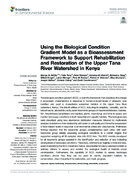| dc.description.abstract | The biological condition gradient (BCG), a scientific framework that describes the change in ecosystem characteristics in response to human-induced levels of stressors, was modified and used to characterize watershed habitats in the Upper Tana River watershed, Kenya. The inbuilt utilities of BCG, including its simplicity, versatility, and its robust nature, allowed its use by seven taxonomic groups of macroinvertebrates, diatoms, fish, herpetofauna (amphibians and reptiles), plants, macrofungi, and birds to assess and monitor landscape conditions in both terrestrial and aquatic habitats. The biological data
were described using taxa abundance distribution measures followed by multivariate analyses to determine their relationship with water or soil quality and thereafter assessment of taxa tolerant levels in response to environmental stress and disturbances. Preliminary findings reported that the taxonomic groups complemented each other, with each taxonomic group reliably assessing ecological conditions to a certain degree that supported assigning all 36 sampled sites into BCG tiers. The BCG models developed for all taxonomic groups assisted in the identification and selection of taxa indicating varying levels of landscape conditions. These taxa, referred to as flagship or indicator taxa, assist in simplifying the BCG model and, hence, are possible for use by parataxonomists or ordinary citizens to assess and monitor the ecological health of habitats under consideration. Furthermore, the capability of BCG models to assess landscape conditions shows how they can be used to identify important habitats for conservation, direct investment for restoration, and track progress | en_US |
